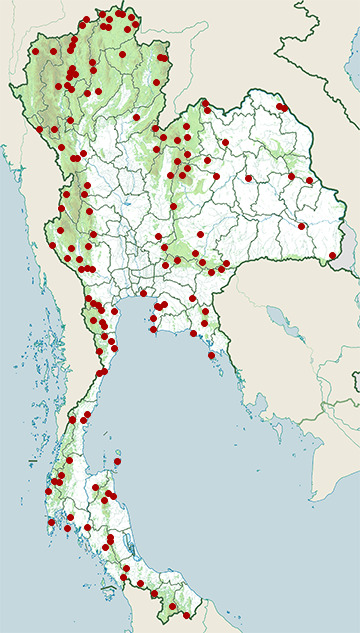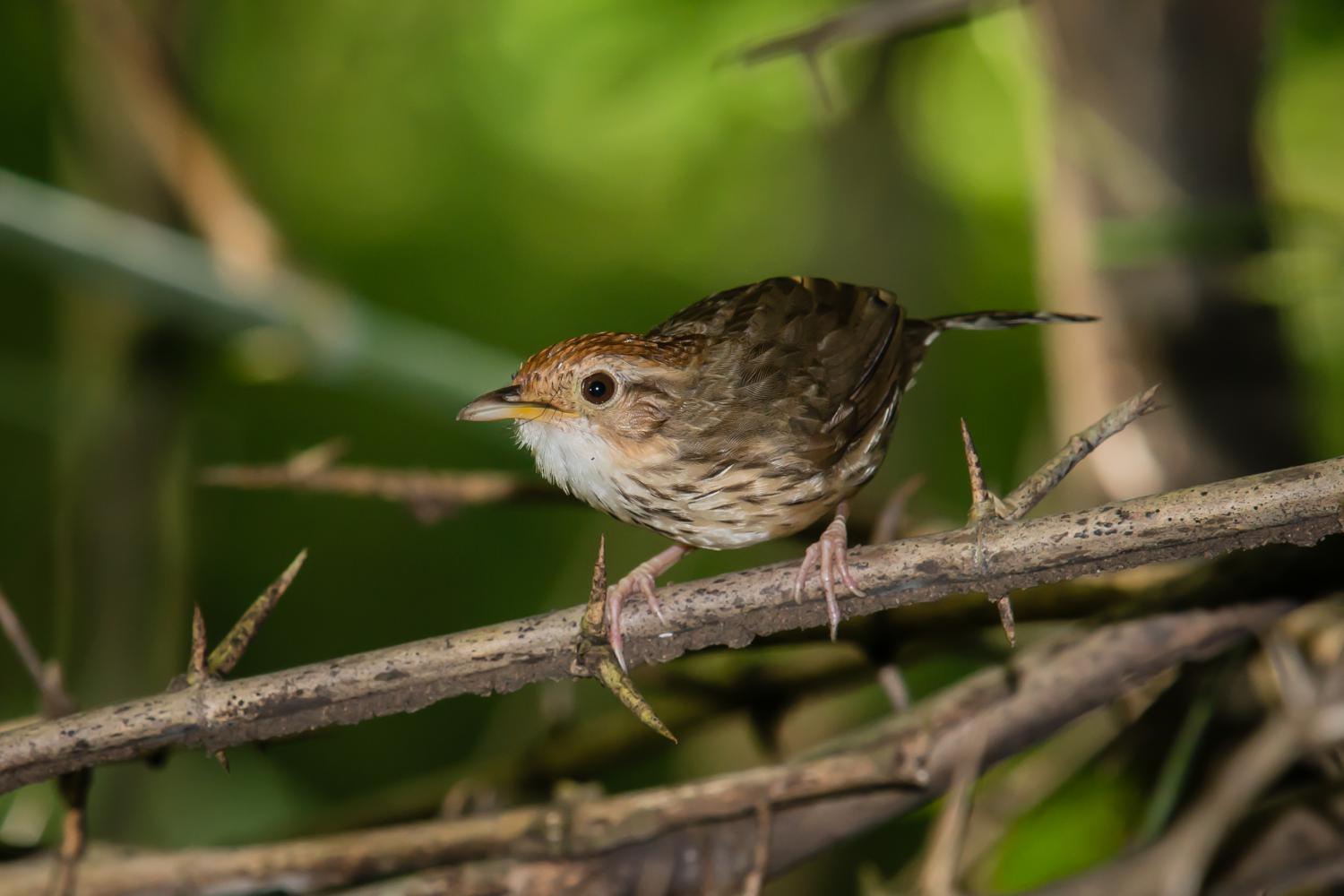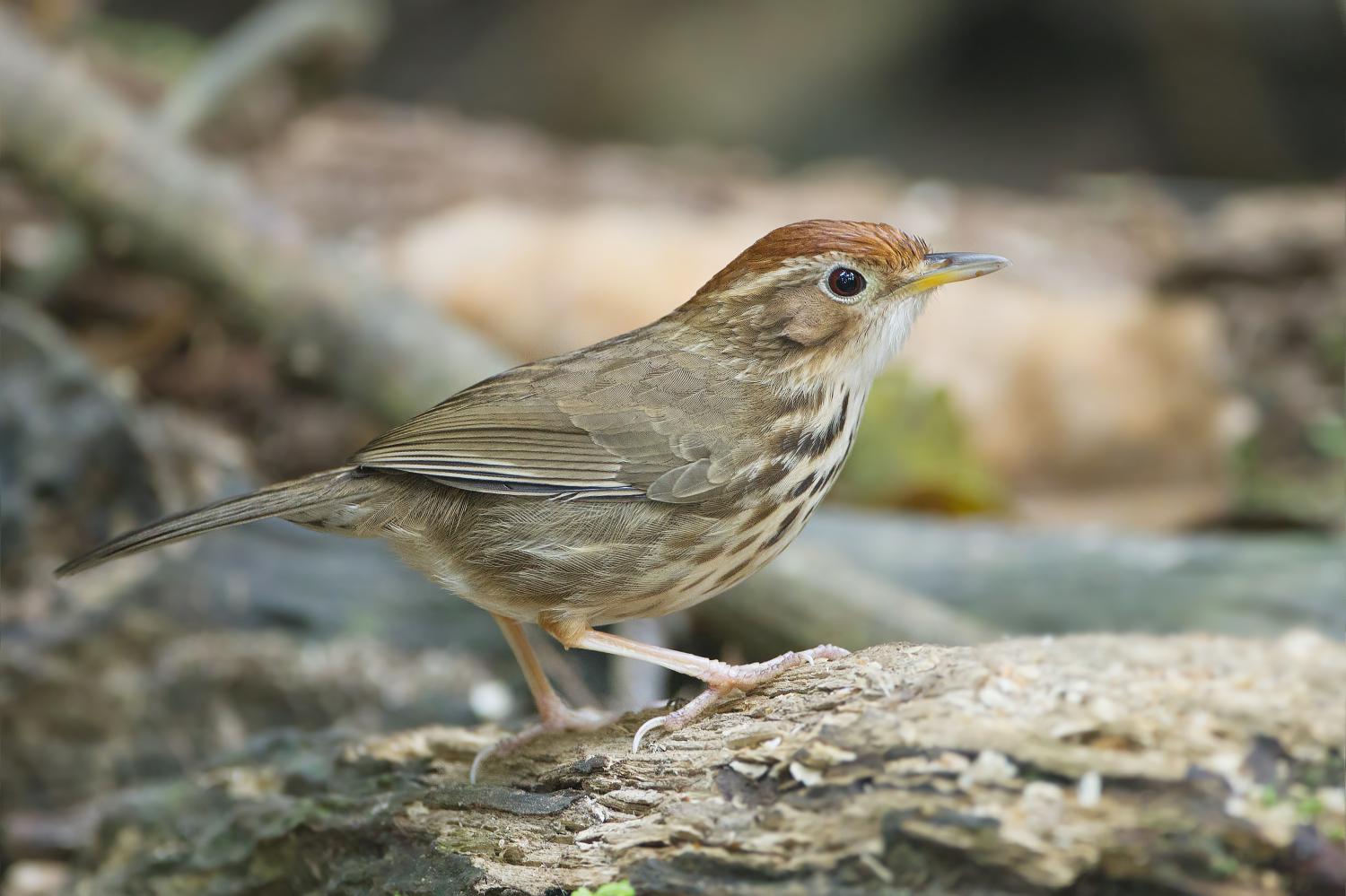Species of Thailand
Puff-throated babbler
Pellorneum ruficeps
William John Swainson, 1832
In Thai: นกจาบดินอกลาย
The puff-throated babbler or spotted babbler (Pellorneum ruficeps) is a species of passerine bird found in Asia. They are found in scrub and moist forest mainly in hilly regions. They forage in small groups on the forest floor, turning around leaf litter to find their prey and usually staying low in the undergrowth where they can be hard to spot. They however have loud and distinct calls, including a morning song, contact and alarm calls. It is the type species of the genus Pellorneum which may however currently include multiple lineages.
Description
Puff-throated babblers are brown above, and white below with heavily brown streaks towards the breast and belly. They have a chestnut crown, long buff supercilium and dusky cheeks. The throat is white, and is sometimes puffed out giving it the English name. Puff-throated babblers have strong legs, and spend a lot of time on the forest floor. They can often be seen creeping through undergrowth in search of their insect food, looking at first glance like a song thrush. Some subspecies have streaks on the mantle while others, especially in Peninsular India, are unstreaked.
The widespread distribution with population variations has led to nearly thirty subspecies being described. The nominate population is found in peninsular India (excluding the Western Ghats). The population in the northern Eastern Ghats is paler and has been called as pallidum while a well marked dark form occurs in the southern Western Ghats which has been named granti (includes olivaceum). The western Himalayas population is punctatum (includes jonesi) and in the east is mandellii which has streaking on the back and nape apart from having call differences. In the east of India, south of the Brahmaputra River occurs chamelum while ripley is found in a small region in eastern Assam (Margherita). Further east in Manipur is vocale and pectorale in Arunachal Pradesh and northern Burma with stageri further south, followed by hilarum, victoriae and minus. Further east are found shanense, subochraceum, insularum, indistinctum, chtonium, elbeli, acrum, oreum, dusiti, vividum, ubonense, euroum, deignani, dilloni and smithi. Several others have been described and many populations are difficult to assign to subspecies. This is the type species for the genus Pellorneum and its generic placement is assured although other species currently included in the genus may be reassigned.
Distribution and habitat
This bird is a common resident breeder in the Himalayas and the forests of Asia. Like most babblers, it is not migratory, and has short rounded wings and a weak flight. Its habitat is scrub and bamboo thickets and forages by turning over leaves to find insects.
Behaviour and ecology
Puff-throated babblers vocalize often. Their calls are a series of whistling notes ascending in scale. Some calls have been transcribed as he'll beat you, pret-ty-sweet. The calling can be persistent. The breeding season is mainly during the rainy season. They build a nest on the ground at the base of bush and is a dome of leaves and twigs with an entrance on the side. The opening usually points downhill when the nest is on sloping ground. The clutch varies from 2 to 5 eggs, with northern populations tending towards larger clutches. Parent birds run rodent-like in the undergrowth as they move in and out of the nest. Young birds fledge and leave the nest about 12 to 13 days after hatching.
This article uses material from Wikipedia released under the Creative Commons Attribution-Share-Alike Licence 3.0. Eventual photos shown in this page may or may not be from Wikipedia, please see the license details for photos in photo by-lines.
Category / Seasonal Status
BCST Category: Recorded in an apparently wild state within the last 50 years
BCST Seasonal status: Resident or presumed resident
Scientific classification
- Kingdom
- Animalia
- Phylum
- Chordata
- Class
- Aves
- Order
- Passeriformes
- Family
- Pellorneidae
- Genus
- Pellorneum
- Species
- Pellorneum ruficeps
Common names
- Thai: นกจาบดินอกลาย
Conservation status

Least Concern (IUCN3.1)
Photos
Please help us review the bird photos if wrong ones are used. We can be reached via our contact us page.
Range Map

- Ban Bueng District, Chonburi
- Bang Lamung District, Chonburi
- Bang Lang National Park
- Bang Phra Non-Hunting Area
- Bueng Khong Long Non-Hunting Area
- Chae Son National Park
- Chaloem Phrakiat Thai Prachan National Park
- Chaloem Rattanakosin National Park
- Chiang Dao District, Chiang Mai
- Chiang Dao Wildlife Sanctuary
- Chiang Khong District, Chiang Rai
- Chiang Saen District, Chiang Rai
- Dan Sai District, Loei
- Doi Inthanon National Park
- Doi Lang
- Doi Lo District, Chiang Mai
- Doi Pha Hom Pok National Park
- Doi Phu Kha National Park
- Doi Suthep - Pui National Park
- Erawan National Park
- Hala-Bala Wildlife Sanctuary
- Hang Chat District, Lampang
- Hat Wanakon National Park
- Hua Hin District, Prachuap Khiri Khan
- Huai Kha Khaeng Wildlife Sanctuary
- Huai Yang Waterfall National Park
- Kaeng Krachan District, Phetchaburi
- Kaeng Krachan National Park
- Kaeng Krung National Park
- Kaeng Som Maew Queen Sirikit Forest Park
- Kanthararom District, Sisaket
- Kantharawichai District, Maha Sarakham
- Khao Ang Rue Nai Wildlife Sanctuary
- Khao Banthat Wildlife Sanctuary
- Khao Dinsor (Chumphon Raptor Center)
- Khao Khitchakut National Park
- Khao Laem National Park
- Khao Luang National Park
- Khao Nam Khang National Park
- Khao Nan National Park
- Khao Phra - Bang Khram Wildlife Sanctuary
- Khao Phra Thaeo Wildlife Sanctuary
- Khao Pu - Khao Ya National Park
- Khao Sam Roi Yot National Park
- Khao Soi Dao Wildlife Sanctuary
- Khao Sok National Park
- Khao Yai National Park
- Khlong Lan National Park
- Khlong Saeng Wildlife Sanctuary
- Khon San District, Chaiyaphum
- Khun Chae National Park
- Khun Nan National Park
- Khun Phawo National Park
- Khun Tan District, Chiang Rai
- Khung Kraben Non-Hunting Area
- Ko Chang National Park
- Ko Samui District, Surat Thani
- Kromluang Chumphon Wildlife Sanctuary
- Kui Buri National Park
- Lam Nam Kok National Park
- Lam Nam Nan National Park
- Lan Sang National Park
- Mae Chan District, Chiang Rai
- Mae Charim National Park
- Mae Fa Luang District, Chiang Rai
- Mae Moei National Park
- Mae Ping National Park
- Mae Rim District, Chiang Mai
- Mae Wong National Park
- Muak Lek District, Saraburi
- Mueang Chiang Mai District, Chiang Mai
- Mueang Chiang Rai District, Chiang Rai
- Mueang Chumphon District, Chumphon
- Mueang Kanchanaburi District, Kanchanaburi
- Mueang Krabi District, Krabi
- Mueang Lampang District, Lampang
- Mueang Loei District, Loei
- Mueang Nakhon Nayok District, Nakhon Nayok
- Mueang Nakhon Ratchasima District, Nakhon Ratchasima
- Mueang Phetchaburi District, Phetchaburi
- Mueang Tak District, Tak
- Na Yung - Nam Som National Park
- Nam Nao National Park
- Nam Phong National Park
- Namtok Mae Surin National Park
- Non Din Daeng District, Buriram
- Nong Bong Khai Non-Hunting Area
- Nong Ya Plong District, Phetchaburi
- Omkoi Wildlife Sanctuary
- Op Khan National Park
- Pa Sang District, Lamphun
- Pachee River Wildlife Sanctuary
- Pai District, Mae Hong Son
- Pang Sida National Park
- Pha Daeng National Park
- Pha Hin Ngam National Park
- Pha Nam Yoi Forest Park
- Phatthana Nikhom District, Lopburi
- Phi Phi Islands
- Phu Chong Na Yoi National Park
- Phu Foi Lom National Park
- Phu Hin Rong Kla National Park
- Phu Khiao Wildlife Sanctuary
- Phu Kradueng National Park
- Phu Langka National Park
- Phu Luang Wildlife Sanctuary
- Phu Sa Dok Bua National Park
- Phu Suan Sai National Park
- Phu Toei National Park
- Phu Wiang National Park
- Pran Buri District, Prachuap Khiri Khan
- Sai Yok District, Kanchanaburi
- Sai Yok National Park
- Sakaerat Environmental Research Station
- Salak Pra Wildlife Sanctuary
- Samut Prakan Province
- San Kala Khiri National Park
- Sangkhom District, Nong Khai
- Sattahip District, Chonburi
- Si Racha District, Chonburi
- Sri Nakarin Dam National Park
- Sri Phang Nga National Park
- Ta Phraya National Park
- Tai Rom Yen National Park
- Taksin Maharat National Park
- Takua Pa District, Phang Nga
- Tat Mok National Park
- Tha Sala District, Nakhon Si Thammarat
- Tha Yang District, Phetchaburi
- Thale Ban National Park
- Thap Lan National Park
- Thong Pha Phum National Park
- Thung Yai Naresuan Wildlife Sanctuary
- Ton Nga-Chang Wildlife Sanctuary
- Umphang Wildlife Sanctuary
- Wang Mai Forest Restoration Project
- Wang Saphung District, Loei
- Wiang Kaen District, Chiang Rai
- Wiang Lo Wildlife Sanctuary
- Yan Ta Khao District, Trang


